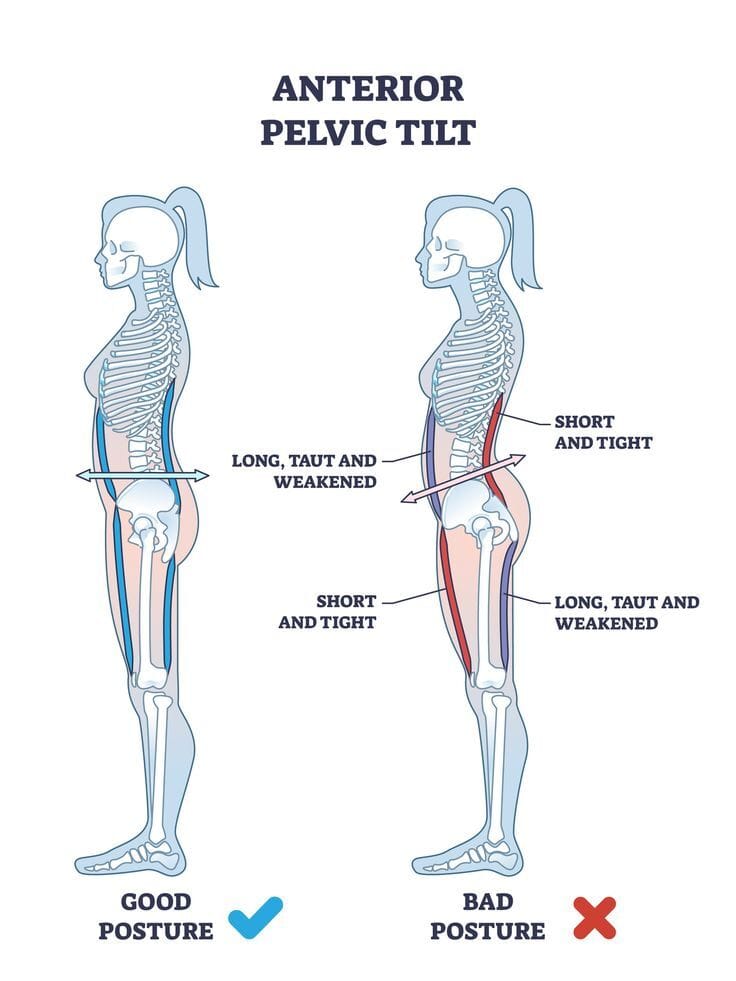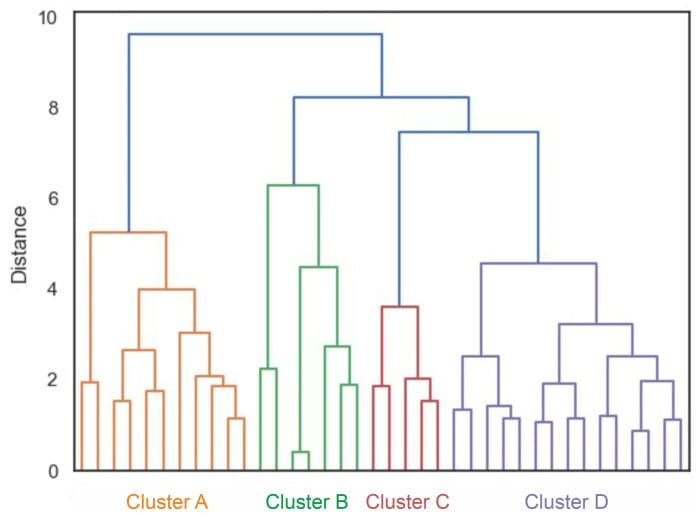- Conquer Club
- Posts
- How to Cure Forward Hips - Fixing the Tilt
How to Cure Forward Hips - Fixing the Tilt

Fixing the Tilt: Muscle Strategies That Actually Re-Align Your Pelvis
Why Anterior Pelvic Tilt Matters
Anterior pelvic tilt (APT) = front of pelvis tips down, back tips up → lumbar spine hyper-arches. Over time this leads to tight hip flexors, weak glutes/abs, and increased spinal load. Modern sitting culture + poor movement variety is the perfect recipe.

This visual shows the classic “red vs blue” model
Red muscles (abs + glutes) pull pelvis into posterior tilt (retroversion).
Blue muscles (hip flexors + erectors) pull it into anterior tilt (anteversion).
It sets the stage: the pelvis isn’t controlled by one muscle but by a push–pull system.

Let’s look into a recent Scientific Study
A 2024 study (Ludwig et al., PMC10885056) tested 41 active men. Each performed 10 voluntary posterior pelvic tilts while EMG measured six muscles: rectus abdominis (RA), obliques (OB), erector spinae (ES), trapezius (TR), glute max (GM), and biceps femoris (BF).

This figure shows where electrodes were placed — abs, obliques, glutes, hamstrings, erectors, traps. It proves the study wasn’t guessing; they captured real activation data across multiple chains.
Results That Matter
Just for clarification once again:
RA = Rectus Abdominis (six-pack abs)
OB = Obliquus (external obliques, side abs)
TR = Trapezius pars ascendens (lower trapezius)
ES = Erector Spinae pars lumbalis (lumbar spinal erectors)
GM = Gluteus Maximus (main glute muscle)
BF = Biceps Femoris (hamstrings)
PT = Pelvic Tilt delta (change in tilt angle)
Still up? Still scrolling? It’s time to turn off.
From the team behind AG1 and AGZ...
Tired of tossing, turning, and scrolling? Pick up the phone.
1-855-TURN-OFF is the first all-night hotline designed to turn you off.
It's simple: dial in, press a button, and hear the sweet science behind AGZ whispered directly in your ear. From magnesium for sleep support, to adaptogens for stress, to L-theanine for relaxation - every call leads to better rest.*
What are you waiting for? Click here for a toll-free and melatonin-free time.
* These statements have not been evaluated by the Food and Drug Administration.
Glute max was the most consistent muscle. No matter the strategy, GM activity correlated strongest with pelvic correction.

shows higher GM activity = greater posterior tilt. The red regression line makes this crystal clear.

Muscle activation levels (%MVC) across the four clusters. Each bar shows how strongly each muscle contributed. Despite differences, the gluteus maximus (GM, green) is consistently active, making it the keystone for pelvic correction.
Cluster A (Abs + Glutes): Rectus abdominis (RA) and obliques (OB) fire strongly, supported by glutes.
Cluster B (Back + Glutes): Erector spinae (ES) and trapezius (TR) dominate, paired with glutes.
Cluster C (Glutes + Hamstrings): Glute max (GM) and biceps femoris (BF) lead, abs stay quieter.
Cluster D (Glute-Centric): Glute max does most of the work, other muscles play a smaller role.
Muscles pair up. RA with OB, and TR with ES, showed natural co-activation.

a dark block between RA/OB and TR/ES highlights these synergies.
Four unique muscle activation “clusters” appeared. All achieved tilt correction equally well.

Dendrogram – splits participants into 4 groups.
The Four Neuromuscular Strategies
🟧 Cluster A — Ab-Dominant
RA + OB strong, with glute assist.
Feels: abs burning in planks/dead bugs.
🟩 Cluster B — Postural Back + Glute
TR + ES work with glutes.
Feels: low back “working” to hold posture.
🟥 Cluster C — Glute–Hamstring
GM + BF dominate; abs quieter.
Feels: glutes/hammies fire first in bridges/hinges.
🟦 Cluster D — Glute-Centric
GM does nearly all the work.
Feels: glute squeeze alone fixes posture.
Why it Matters for Training Solutions
There isn’t one universal solution. Strengthening abs may not help if your CNS never calls on them for pelvic control.
The glute max is always involved — it’s the anchor muscle.
Train according to your cluster → reinforce what your body naturally recruits, then work on weak CNS connections once your base is covered.
Quick Self-Test to Find Your Cluster
Glute bridge – if you feel it mostly in the glutes, you’re likely Cluster D; glutes + hamstrings = Cluster C; strong ab bracing = Cluster A.
Plank – abs burning = Cluster A; low back straining = Cluster B.
Daily posture cues – back tightness when standing long = Cluster B; hammies light up walking uphill = Cluster C; abs bracing naturally = Cluster A; glutes snapping pelvis neutral = Cluster D.
A Note on Adaptability
The study separates the clusters clearly, but your body isn’t locked into one box forever. Humans are adaptable. With training, breathing focus, and intentional movement, you can strengthen a weaker cluster or refine how your body naturally stabilizes the pelvis.
If you know you have an underdeveloped cluster (say, weak abs or hammies), start gently. Think mind–muscle connection first, load second. Breath control, slow execution, and practice pristine form matter more than volume or weight.
Remember: science gives us the framework, but your body gives the feedback. What feels right, what improves your posture, and what reduces discomfort should guide your adjustments.
Conquer Cluster-Specific Plans
🟧 Cluster A (Abs + Glutes)
Dead Bug 3×8/side
Side Plank Reach 3×30s
Glute Bridge w/ PPT cue 3×12
Farmer’s Carry 4×30m
🟩 Cluster B (Back + Glutes)
Trap-3 Raise 3×12–15
Bird Dog 3×8/side
McGill Curl-Up 3×12
Glute Bridge March 3×8/side
🟥 Cluster C (Glute–Hamstring)
Hip Thrust 4×10–12
RDL 3×8
Copenhagen Plank 3×20s/side
Hanging Knee Raise 3×10
🟦 Cluster D (Glute-Centric)
Bulgarian Split Squat 3×8/side
Pallof Press + Step-Out 3×10/side
Single-Leg RDL 3×8/side
Side Plank Row 3×10/side
Mobility + Awareness Add-On
Half-Kneeling Hip Flexor Stretch 2×30s
90/90 Breathing 3×5 breaths
Pelvic Clocks 1×10 circles
Prone Hip IR Sweeps 1–2×10
Bringing It All Together
The study’s conclusion: “Different people use different motor strategies, but the glute max is always central.”
The truth here:
Everyone needs glute max.
Some need abs, some hammies, some postural endurance.
Your nervous system picks the cluster; your training amplifies it.
When you build strength + awareness in the right muscle chain, you don’t just fix your posture; you free up movement, load capacity, and performance across the board.
Next Step: Join the Movement
The research provides the framework, but your progress comes from applying it. If you want direct feedback, community accountability, and access to deeper Conquer protocols:
Join the Conquer Club Telegram: t.me/+C20JZKXqqeE3NGFh
Apply for 1:1 Conquer Coaching: t.co/g9mVZ8CzvZ
Your pelvis doesn’t just need theory; it needs consistent, focused training.
Your Coach,
Joshua

